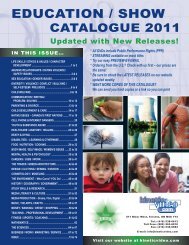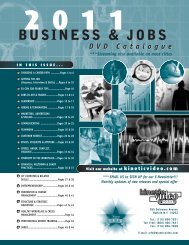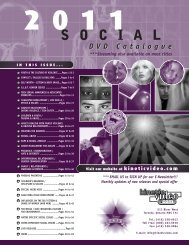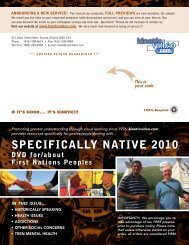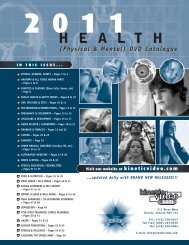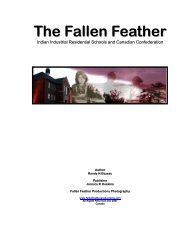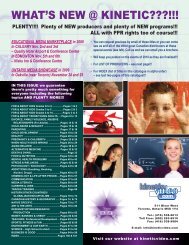WHAT'S NEW @ KINETIC???!!! - Kinetic Video
WHAT'S NEW @ KINETIC???!!! - Kinetic Video
WHAT'S NEW @ KINETIC???!!! - Kinetic Video
Create successful ePaper yourself
Turn your PDF publications into a flip-book with our unique Google optimized e-Paper software.
PHYSICS IN ACTION SERIES<br />
Can the study of physics be fun? This clever five-part series answers "Yes!" by presenting essential facts, formulas, and laws<br />
of physics through real-world examples, illustrative animations, and a likeable field guide named Mr. Physics who makes<br />
complicated concepts easier to understand. End-of-section reviews are included throughout each program, and equations are<br />
worked out, step by step, on-screen.<br />
ENERGY - Talking about energy is tricky because everyday words can also have specialized scientific meanings. Through the<br />
process of defining key terms like "power", "work", and even "energy" itself, this program uses a roller coaster, a harmless<br />
train wreck, ice-skaters, a boulder, a human cannonball, night-vision goggles, and a supernova to introduce students to<br />
kinetic and potential energy, electrical energy, chemical energy, nuclear energy, and conduction, convection, and radiation<br />
of heat.<br />
FORCES AND MOTION - In New York City, there are many ways to travel. Of course, it's a lot easier if you're a bird. Using the<br />
Big Apple as a living laboratory, this program addresses speed and distance using a pigeon, a taxi, and a tour boat. Additional<br />
situations such as the deployment of a Mars rover, a zero-G flight in NASA's Weightless Wonder, a walk on a conveyor belt and<br />
a cruising aircraft carrier, and juggling on the Earth and around the Solar System provide opportunities to study the<br />
mechanics of velocity and acceleration as well as contact forces and forces that act at a distance. Vector algebra is<br />
demonstrated throughout.<br />
PLANETS, STARS AND GALAXIES - Beginning with the history of astronomy (Ptolemy, Copernicus, Giordano Bruno, Galileo),<br />
this program considers the mathematics of motion (velocity, acceleration); gravity (Kepler's discoveries, Newton's laws,<br />
center of gravity, astronomical units); the properties of stars (parallax, flux, luminosity, color, Hertzsprung-Russell diagram);<br />
relativity (Einstein's theories, speed of light, space-time); and the large-scale structure of the universe (Big Bang,<br />
Cosmological Principle, Hubble's law). Humankind has come a long way in our understanding of the cosmos - but we're still<br />
only scratching the surface of astrophysics, with discoveries of incalculable value still waiting to be made.<br />
PROCESSES THAT SHAPED THE EARTH - The Earth is like a living, breathing organism. From its molten core to the upper<br />
reaches of the atmosphere, nothing is still. How was the planet formed, and what are the forces that continue to sculpt it?<br />
This program uses animated topographical maps, a broken pane of glass, a fortune in diamonds, a floor-sanding machine,<br />
stalactites, flowing glaciers, a merry-go-round, a greenhouse, and more to help students visualize the structure and<br />
composition of the Earth and the processes that shape our world. Dangerous impacts of humankind - most notably pollution<br />
and deforestation - are also considered.<br />
THE NATURE OF MATTER - An elephant and a racing car don't have much in common - except for the remarkable fact that<br />
they're made of similar fundamental building blocks. This program takes a simulated subatomic look at a glass of water to<br />
better understand the nature of matter, a minuscule world of molecules, atoms, and elementary<br />
particles. The behavior of matter under the effects of gravity, electromagnetism, and the strong<br />
and weak nuclear forces; the process of scientific experimentation; specifics of atomic structure;<br />
the organization of matter via the periodic table; ionic, covalent, and hydrogen bonding; the<br />
process of radioactive decay; and the death of fusion-fueled stars are scrutinized as well.<br />
#12940/0635 Five 25 minute programs 2009 Includes Guides $129.95 each or Series $598.95<br />
THE STARCHASERS SERIES<br />
This six-program series is astronomy and space science on the edge. On the edge of technology -<br />
both personal and professional tools to see the skies as never before. On the edge of our map -<br />
from the deserts of New Mexico to the Canadian prairies and the high arctic of the Norwest<br />
Territories. On the edge of the known Universe - exploring stellar graveyards and searching for<br />
ghostly dark energy amidst the galaxies. And on the edge of understanding - facing questions<br />
about life and the Universe that almost every person has asked themselves, and which baffle top<br />
scientists to this very day. Features our distinguished host and member of the Order of Canada<br />
astrophysicist and professor of astronomy Dr. Jaymie Matthews of the University of B.c.<br />
TO THE LAND OF THE NORTHERN LIGHTS - For times immortal, the Aurora Borealis has spurned<br />
man's imagination. Together with our host and astronomer Dr. Jaymie Matthews we travel to Canada's Northwest Territories<br />
to view and photograph the aurora's brilliant curtain of color, one of nature's most unique phenomena. #11573<br />
GALACTICA INCOGNITA - Our infrared look at the center of our own galaxy leads us to the Dominion Radio Astrophysical<br />
Observatory in the Okanagan Valley near Penticton, where astronomers are using invisible radio waves to map the Milky Way.<br />
WE ARE STARDUST - Professor Chris Pritchett and his colleague Dr. Dave Ballam are working at the University of Victoria,<br />
where they are involved with the intergalactic sky survey of supernovae. Data from the Canada-France-Hawaii Telescope in<br />
Hawaii is sent to Victoria where it is stored and deciphered by a number of supercomputers. Dr. Ballam explains the intricacy<br />
and importance of this research. #11575<br />
ROCKS FROM HEAVEN - The Prairie Meteorite Search is carried out annually by an undergrad from the University of Calgary,<br />
who travels to Saskatchewan and Manitoba looking for new meteorites.<br />
Dr. Alan Hildebrandt, the Chair for Planetary Sciences at the U of C, introduces us to meteorites, after which we follow his<br />
student to the prairies for the annual event. #11576<br />
OF EARTH, PEOPLE, AND SKY - In the southwestern deserts of New Mexico, ancient petroglyphs may have recorded historical<br />
astronomical events and the supernova explosion of 1054. We travel to this remote area where we look for petroglyphs left<br />
by the Mimbres people over a thousand years ago, as well as being introduced to the local and more recent history. #11577<br />
M.O.S.T.'S VOYAGE OF DISCOVERY - The voyage of Canada's first space telescope began in Russia in 2003, when the M.O.S.T.<br />
satellite was launched aboard a Russian ex-ICBM. Dr. Jaymie Matthews, Chief Scientist of the project, explains the<br />
outstanding research carried out by the satellite, including the search for extra-solar planets like our planet Earth. #11578<br />
#11570/1735 Six 24-minute programs 2007 P.A.C.S. $129 each or Series $595 *Canadian Production<br />
93





